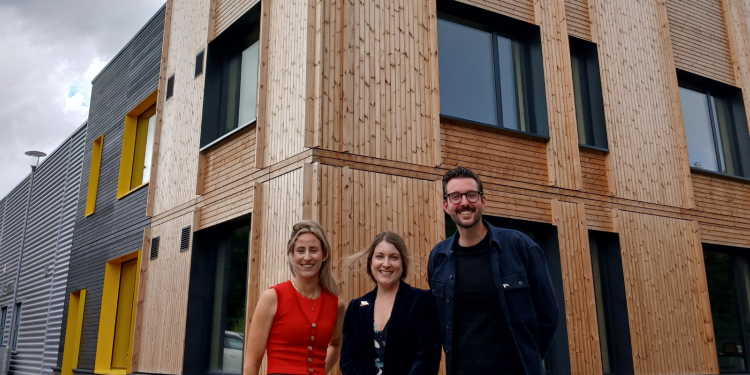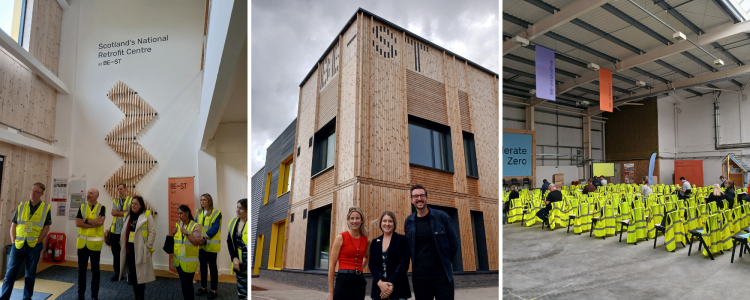Scotland's National Retrofit Centre upgrade shows 'sky's the limit' with seed funding

- Scotland's National Retrofit Centre relaunched following retrofit
- Centre has become more energy efficient and lowered carbon emissions
- Developments included replacing a gas boiler with solar panels and a heat pump
- Part-funded by £1.2m from Scotland's Public Sector Heat Decarbonisation Fund, delivered by Salix on behalf of the Scottish Government
A project to decarbonise Scotland's National Retrofit Centre has been hailed as a huge success and an example to the sector at its offical relaunch.
The centre at BE-ST's innovation campus in Hamilton, which had been powered by a gas boiler, now uses solar panels and heat pumps instead.
The work was part-funded through Scotland's Public Sector Heat Decarbonisation Fund, with the £1.2m award delivered by Salix on behalf of the Scottish Government.
"This shows that the sky's the limit to what you can do with a little bit of investment and maximising what you can do by being ambitious and really going over and above where you can," said Kat McKinnon, head of public sector decaronisation for the Scottish Government.
Retrofit is so important. 85% of buildings existing today will exist in 2045, so that’s a massive number of assets that need to be retrofitted.
Around 150 partners and stakeholders attended the launch including industry leaders, academics, policymakers and innovators. The event included tours of the innovation centre site, speeches, Q-and-A sessions and a networking lunch.
"Retrofit is so important," said Caitriona Jordan, BE-ST's associate director for retrofit and energy efficiency. "Something like 85 percent of our buildings existing today will be in existence in 2045, so that's a massive amount of assets that we need to improve their energy performance.
"We're talking about reducing energy demand, improving the building's performance through fabric measures, reducing moisture build-up, which can cause condensation, reducing overheating in the building and really ensuring the building's resilient for climate change but also to move away from gas."
CEO of BE-ST Stephen Good said: “Today marked the official opening of our two new buildings - the Mass Timber Centre of Excellence and Scotland’s National Retrofit Centre – which are designed to give our sector the tools, expertise, and space it needs to overcome barriers and respond to a number of key challenges, including skills gaps and housing and climate crises. Through these facilities, BE-ST will continue to support innovation, collaboration and skills development that will drive economic growth, improve delivery of the built environment, and benefit communities across Scotland and the wider UK.”
The big success of this is that in isolation the innovation can't happen that really when we come together and work together we can push the envelope of what is possible.
"We've done a deep retrofit with a fabric first approach to decarbonise the heat source and transform a turn-of-the-century 2000 build industrial unit into a living lab learning environment for the sector to understand what it means to retrofit a building," said Gavin Johnston, BE-ST's associate director for collaborative and commercial partnership.
"So, someone could take this and replicate it within our building here or we could take aspects of it, we could take the zero direct emissions heating system and we could replicate that somewhere else because of the efficiency we get by utilizing the PVT array with the modified ground source heat pump. So there's lots of different things within this menu of approaches that I would like to see others take forward.
"The big success of this is that in isolation the innovation can't happen that really when we come together and work together we can push the envelope of what is possible. We really saw the funding as seed-funding in order to help us to unlock other investments that we wanted to make and we were absolutely really incredibly grateful to Scottish Government and Salix for working with us and our host, Edinburgh Napier University."

How was the retrofit funded?
Edinburgh Napier University, administrator of BE-ST, was awarded £1.2m through Phase 1 of Scotland’s Public Sector Heat Decarbonisation Fund, which is delivered by Salix on behalf of the Scottish Government.
Funding supported the retrofit of the Accelerator Lab at BE-ST’s Campus as part of a programme for heat decarbonisation and retrofit energy efficiency measures that support the overall decarbonisation of heat in buildings across Scotland’s public sector.
What happens at BE-ST?
The BE-ST innovation centre is made up of two buildings - Scotland's National Retrofit Centre, and the Mass Timber Centre of Excellence. Having now re-opened, the retrofit centre aims to:
- support the construction sector to tackle the challenge of retrofitting existing buildings
- improve the quality, comfort and energy performance of buildings across the UK
- provide a space for hands-on training and demonstration of retrofit technologies
- be a home of collaboration between academia, industry and government and public sector clients
The timber centre aims strengthen local supply chains, create jobs and reduce carbon emissions by accelerating the adoption of UK-grown mass timber solutions - resulting in significant economic, environmental and social benefits.
BE-ST's goal is to accelerate the built environment’s transition to zero carbon. It works with the construction and built industry at all levels, as well as education and the public/third sector, all as part of its aim to build smarter and more sustainably.
September's event, held at BE-ST’s Innovation Campus in Hamilton, marked the first event in the BE-ST Fest 2025 Fringe Festival.
Main picture, from left:
- Caitriona Jordan, associate director for retrofit and energy efficiency, BE-ST
- Kat McKinnon, head of public sector decarbonisation, Scottish Government
- Gavin Johnston, associate director for collaborative and commercial partnership, BE-ST




